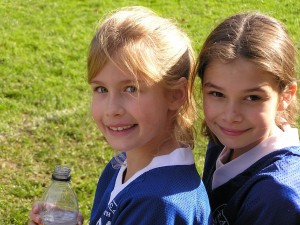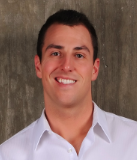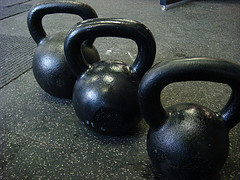Lessons to Teach Young Athletes
By Mike Robertson

The past couple of weeks have been a whirlwind, as I’ve been on the floor a bunch and coaching some really fun athletes.
As a result, I’ve been reflecting on some of the lessons I’ve tried to teach my young athletes along the way. Each and every kid is a little bit different and has unique things they need to address to become the kind of athlete (or human being) we know they’re capable of.
Here are five lessons that I feel we as coaches should teach every young athlete we come in contact with.
Lesson #1: Recovery Is Critical
Think back to when you were a teenager.
Chances are you stayed up too late, did dumb things with your friends, and weren’t quite the upstanding individual you are now.
And that’s OK—that’s how we all learn and grow.
But as tough as we all had it, I would argue that today’s kids have it worse in a handful of ways than we did.
Sure, there are a lot of similarities such as school, athletics, and extracurricular activities, but I would argue there’s one big difference between then and now:
Kids today carry a tremendous burden when it comes to social pressures and expectations.
Yes we played sports, went to school, and did other stuff, but there’s never been the amount of pressure on our youth as there is today.
As such, we need to teach them the value of rest and recovery.
Instead of 5 or 6 hours of sleep per night, they should be getting at minimum 7 or 8.
We need to teach them that it’s OK to relax and unwind. Turn the cell phone, iPad, and laptop off for a while and just chill out. (I’m always shocked at how much more laid back and relaxed I am when I just unplug for a while).
And of course, eating to fuel your training is critical (more on this below).
The bottom line is that recovery is critical. If we’re going to be asked to perform at a high level in the classroom, on the field, and in everyday life, that’s fine, but there has to be a balance between performance and recovery.
Lesson #2: Nutrition Is Fuel
This goes hand in hand with my previous point, as nutrition is a huge component of recovery.
And I can’t give you a better example than a kid I used to work with called “Juice.”
Juice played basketball at the high school I worked at. He had a ton of energy and was always fun to be around, so it wasn’t uncommon for me to spend quite a bit of time chatting him up and joking around.
One day I show up to train the team at 3 pm, and Juice is telling me how tired he is.
Me: “What did you eat today?”
Juice: “Nothing, but I just had a Mountain Dew, so I’m cranked and ready for practice coach!”
Me: “No, seriously, what did you have for breakfast and lunch?”
Juice: “Nothing. I was late for school so I skipped breakfast, and then I had homework to do during lunch so I forgot to eat something.”
I wish this was a joke, but it wasn’t. This kid was going to lift weights and go to basketball practice, having only had a 20-ounce Mountain Dew the entire day.
Athletes can be all over the board with their nutrition, so it’s always a tightrope when getting them focused and dialed in. Some can eat anything and everything and get away with it, while others are far more focused on their body and physique than how food will fuel their performance.
Female athletes need even more time, attention, and care.
There are all kinds of social pressures and stresses when it comes to females and food, so if I have an inkling that a female athlete may have food issues, I’m quick to punt that situation to the appropriate professional.
Suffice it to say, though, we need to give our young athletes a basic understanding of why eating properly is important.
The best avenue I’ve always found was to remind your athletes that food is fuel. What you put into your body every meal is going to determine how well you play on the court or field.
Do you really think that Twinkie, candy bar, or Pop Tart is really going to improve your performance?
And rather than focusing on portion sizes and giving out “diets” (which is where you should lean on the expertise of a dietitian or similar professional), I like to discuss some of the nutritional basics with my athletes:
- Get some lean protein at every meal.
- Get a vegetable and/or fruit at every meal.
- Carbs aren’t the devil, but they’re easy to over consume.
- Ditto on fats, and we need goods fats in our diet.
- Hydration is critical, so shoot for 1/2 ounce per pound of body weight daily.
If we can get our athletes following the basic nutritional tenets I’ve provided above, they’ll be in vastly superior shape compared to many of their peers.
Lesson #3: You Need a Strong Foundation
As strength coaches, this may be the greatest thing we can give our athletes.
If you work with middle school and high school age kids, this is arguably the single best time to come in contact with a kid. They’re incredibly malleable, whether we’re talking about mobility, stability, strength, etc.
But perhaps more importantly, they’re much more open-minded or “mentally malleable” than some of the older clients we come in contact with. They don’t have preconceived notions as to how much range of motion they should have, how strong they should be, etc., so there’s far less resistance when we introduce them to an exercise program.
At this age, we can give them an amazing movement foundation, and I would argue this should be the single biggest focus of our training.
It starts by having them play as many sports as possible while growing up. The proper term for this is long-term athletic development (LTAD), and it’s something we preach to our kids.
Stop it with the year-round sports, travel league teams, and all the other garbage that just makes people feel superior or awesome.
Nobody remembers when they’re in their 30s or 40s that they played on the U-7 travel team. But I guarantee they’ll remember if they ended up having a Tommy John surgery as a result!
In the gym, teach them the basics of movement. Teach them how to squat, lunge, hinge, push-up, row, chin, and enjoy the amazing body they were given.
In the beginning, it’s not even about load or performance; it’s about exploration and allowing them to feel what their body can do.
In fact if you follow the teachings of Professor Zatsiorsky, he’s a huge proponent of the three year rule:
No external loading for the first three years of an athlete’s development.
If nothing else, teach these kids to move really well, and then teach them to move weights, or to move for an extended period of time.
Remember, this is the body they will live in the rest of their lives. Our goal should be to give them a rock-solid foundation that will last them a lifetime.
Lesson #4: Learn How to Breathe
One of the big things we assess at IFAST is how a client breathes.
Not surprisingly, a lot of people these days breathe horribly. The only two places they can draw in air is by “pushing” it into their belly or “pulling” it into their neck by using accessory muscles like the scalenes and SCM.
Not only does this lead to performance issues on the field/court, but it can drive physiological issues off the field. Whether it’s increased anxiety and stress, trouble falling asleep, or issues staying asleep, breathing is something we need to address.
If you follow the R7 approach that we do here at IFAST, we put a premium on quality breathing. Not only will clients get to work on this during their warmup, but perhaps even more importantly, they will also work on it at the conclusion of their workout.
Even if you’ve never done this, have your athletes lie on their back at the end of a session with their knees bent and feet flat on the floor.
Tell them to breathe in through their nose, take approximately 5 seconds to get the air in.
Follow that up with a complete exhale through the mouth, which should take about 10 seconds.
Finish by holding that fully exhaled position for 3-5 seconds, and then repeat for 8-10 breaths.
It doesn’t sound like a lot, but teaching a young athlete to breathe is just as foundational as good movement. Not only can they see performance improvements on the field, but chances are they’ll be less stressed out and anxious off it as well.
Lesson #5: The Weight Room Is a Classroom
The final thing I love to teach my young athletes is that the weight room (and especially my weight room) is a classroom.
At the risk of sounding hokey, it’s a classroom, and the class I’m teaching is L-I-F-E.
If you are serious and committed to improve your body and your performance, just think about all the lessons you can learn about:
Work ethic.
Desire.
Commitment.
Goal setting.
Loyalty.
The list of positive traits goes on and on.
And when an athlete comes into my weight room, I always have two things in the back of my mind.
Firstly, I always want the kids who train with me to have fun. This shouldn’t be another thing they have to do; I want this to be something that want to do.
Secondly, I always want the kids I train to look at me as a role model, or someone they can look up to and trust. I don’t consider myself to be perfect or beyond reproach, but I’m always thinking about carrying myself with a high level of character and self-respect.
Chances are if you’re reading this, you’re a pretty upstanding and legit person. Kudos to you.
But when I look around, not all the kids we come in contact with have a stable social foundation.
These kids need strong and stable individuals who they can look up to and trust, so that they can in turn become better people.
It frustrates me to no end when people talk poorly about young people. Sure, there are always going to be some bad seeds. Growing up, I know I had some bad appples around me.
But throwing this generation as a whole under the bus is a massive cop out.
Rather than simply saying, “These kids don’t get it,” or bitching about how entitled today’s youth is, I think it’s far more beneficial to take a long, hard look in the mirror and consider what we can do to help these kids become the kind of young adults we know they can be.
Take the time to nurture your young athletes both physically and psychologically.
Put them in a positive environment, give them solid footing, and allow them to have some success.
And don’t forget to show them how powerful the weight room can be. I can tell you without a doubt I wouldn’t be the husband, father, business owner or athlete I am today without the lessons I’ve learned in the weight room.
Summary
I consider myself to be incredibly lucky. Over the years, I’ve gotten to work with thousands of athletes, and I hope that I’ve successfully passed on some of the knowledge that I’ve picked up along the way.
If you work with young athletes, or if you have young athletes in your home, take this post to heart. Maybe pass it along to someone else you think could benefit from my message.
And most importantly, remember how powerful we are in the lives of today’s youth. Every single day we can make a difference, so do your best to make it a positive one.
All the best,
MR
Want more free content to help you be a better coach?
Watch this free video from Wil Fleming on the 5 Factors of Athleticism and learn how to help your athletes go from good to great.

Get the Free Video Series Now







 Seriously, they can go anywhere! Resistance bands don’t take up a ton of space, and they aren’t heavy or hard to transport. Stick them in your trunk and use them in every session! (They are 100% TSA approved so you can even fly with them.) 😉
Seriously, they can go anywhere! Resistance bands don’t take up a ton of space, and they aren’t heavy or hard to transport. Stick them in your trunk and use them in every session! (They are 100% TSA approved so you can even fly with them.) 😉
 Julie is the Executive Director of the International Youth Conditioning Association (IYCA). She grew up as an athlete and played collegiate softball at Juniata College. She currently owns and operates her own youth fitness business pouring into young athletes. Her areas of expertise are youth sport performance, youth fitness business and softball training/instruction. Julie grew up on a dairy farm and can challenge the best of the best in a cow-milking contest. 😉
Julie is the Executive Director of the International Youth Conditioning Association (IYCA). She grew up as an athlete and played collegiate softball at Juniata College. She currently owns and operates her own youth fitness business pouring into young athletes. Her areas of expertise are youth sport performance, youth fitness business and softball training/instruction. Julie grew up on a dairy farm and can challenge the best of the best in a cow-milking contest. 😉















